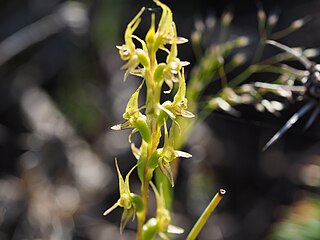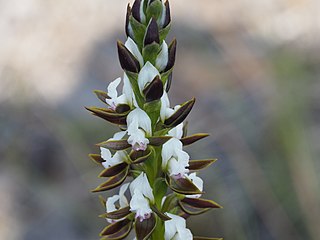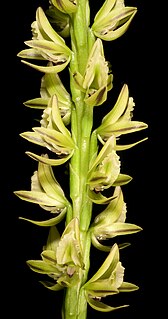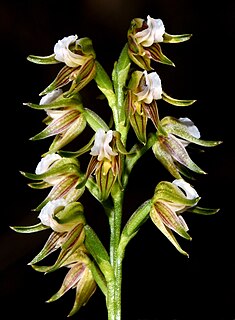
Prasophyllum gracile, commonly known as the little laughing leek orchid, is a species of orchid endemic to the south-west of Western Australia. It is one of the most common and widespread orchids in the south-west and has a single smooth, tube-shaped leaf and up to forty or more, usually yellowish-green flowers.

Prasophyllum sargentii, commonly known as the frilled leek orchid, is a species of orchid endemic to the south-west of Western Australia. It is a tall orchid with a single smooth, tubular leaf and up to thirty or more purplish and white or golden brown and white flowers with a frilled labellum.
Prasophyllum amoenum, commonly known as the dainty leek orchid or Snug leek orchid, is a species of orchid endemic to Tasmania. It has a single tubular, green leaf with a purplish base and between five and twelve light green, dark brown and white flowers. In 2007, the entire population was estimated to be about 600 plants.
Prasophyllum anticum, commonly known as the Pretty Hill leek orchid, is a species of orchid endemic to Victoria. It has a single tubular, dark green leaf and between ten and twenty five scented, greenish-brown flowers and is only known from a small area in the south-west of the state.

Prasophyllum fimbria, commonly known as the fringed leek orchid, is a species of orchid endemic to the south-west of Western Australia. It is a tall orchid with a single smooth, tube-shaped leaf and up to seventy greenish-brown flowers with a white and pink labellum.

Genoplesium nigricans, commonly known as mallee midge orchid, is a species of orchid endemic to a Australia. It is a terrestrial herb with a single leaf mostly surrounding the stem, and up to 50 tiny, greenish flowers with a deep maroon-coloured labellum and often have a fruity fragrance. Australian authorities use the name Corunastylis tepperi, a widespread species which has been confused with Corunastylis nigricans, a species with purplish brown flowers and which only occurs on Kangaroo Island and the Eyre Peninsula.

Prasophyllum brownii, commonly known as the Christmas leek orchid, is a species of orchid endemic to the south-west of Western Australia. It is one of the last of the genus in Western Australia to flower and has a tall flowering stem with up to eighty pale green and fawn-coloured flowers.

Prasophyllum caudiculum, commonly known as the Guyra leek orchid, is a species of orchid endemic to a small area of northern New South Wales. It has a single tubular, bright green leaf and up to thirty five greenish to reddish-brown flowers crowded along an erect flowering stem. It grows in grassy places near Guyra.
Prasophyllum crebriflorum, commonly known as the crowded leek orchid, is a species of orchid endemic to Tasmania. It has a single tubular, dark green leaf with a purplish base and up to twenty five reddish-brown flowers. It is only known from four relatively small populations growing at high altitudes.
Prasophyllum cucullatum, commonly known as the hooded leek orchid, is a species of orchid endemic to the south-west of Western Australia. It is a tall orchid with a single smooth, tubular leaf and up to fifty or more purplish-red and white flowers with a frilled labellum crowded along a relatively short flowering stem.

Prasophyllum cyphochilum, commonly known as the pouched leek orchid, is a species of orchid endemic to the south-west of Western Australia. It is a relatively common orchid with a single smooth, tubular leaf and up to thirty or more pale yellow and brown flowers. The flowers do not open fully, are more or less cup-shaped and have a "humped" labellum.
Prasophyllum gibbosum, commonly known as the humped leek orchid, is a species of orchid endemic to the south-west of Western Australia. It is a late-flowering leek orchid with a single smooth, tubular leaf and up to eighty or more purplish-red and white flowers with a smooth labellum. It is similar to P. cucullatum but that species has a frilly labellum, usually a shorter flowering stem and an earlier flowering period.
Prasophyllum giganteum, commonly known as the bronze leek orchid, is a species of orchid endemic to the south-west of Western Australia. It is a tall, fragrant leek orchid with a single smooth, tubular leaf and up to fifty or more green and pinkish-purple flowers with a frilly labellum.
Prasophyllum limnetes, commonly known as the marsh leek orchid, is a species of orchid endemic to Tasmania. It has a single tubular, green leaf and up to thirty five greenish-white flowers with a pinkish labellum. It is only known from a population of fewer than twenty plants growing in a sanctuary near Port Sorell.
Prasophyllum macrotys, commonly known as the inland leek orchid, is a species of orchid endemic to the south-west of Western Australia. It has a single tubular leaf and up to thirty greenish to purplish flowers and is similar to the tall leek orchid but has smaller, darker flowers.

Prasophyllum parvifolium, commonly known as the autumn leek orchid, is a species of orchid endemic to the south-west of Western Australia. It is a common species in its range and has a single smooth, tube-shaped leaf and up to eighteen or more green and white flowers with red stripes.
Prasophyllum odoratissimum, commonly known as the scented leek orchid or fragrant leek orchid, is a species of orchid endemic to Western Australia. It has a single smooth, tubular leaf and up to thirty or more scented, greenish, white and fawn-coloured flowers with a labellum which is often bent backwards. It was formerly included in Prasophyllum odoratum.
Prasophyllum ovale, commonly known as the little leek orchid, is a species of orchid endemic to the south-west of Western Australia. It is a small leek orchid with a single smooth, tubular leaf and up to twenty or more white, green and brown flowers with the labellum only slightly upturned.
Prasophyllum paulinae, commonly known as Pauline's leek orchid, is a species of orchid endemic to the south-west of Western Australia. It is a small, rare leek orchid with a single smooth, tubular leaf and up to seventy yellowish-green and purple flowers.
Prasophyllum regium, commonly known as the king leek orchid, is a species of orchid endemic to the south-west of Western Australia. It has a single, unusually thick tubular leaf and up to one hundred relatively large, greenish-brown or burgundy-coloured flowers. It is one of the tallest leek orchids, sometimes growing to a height of 2 m (7 ft).

















